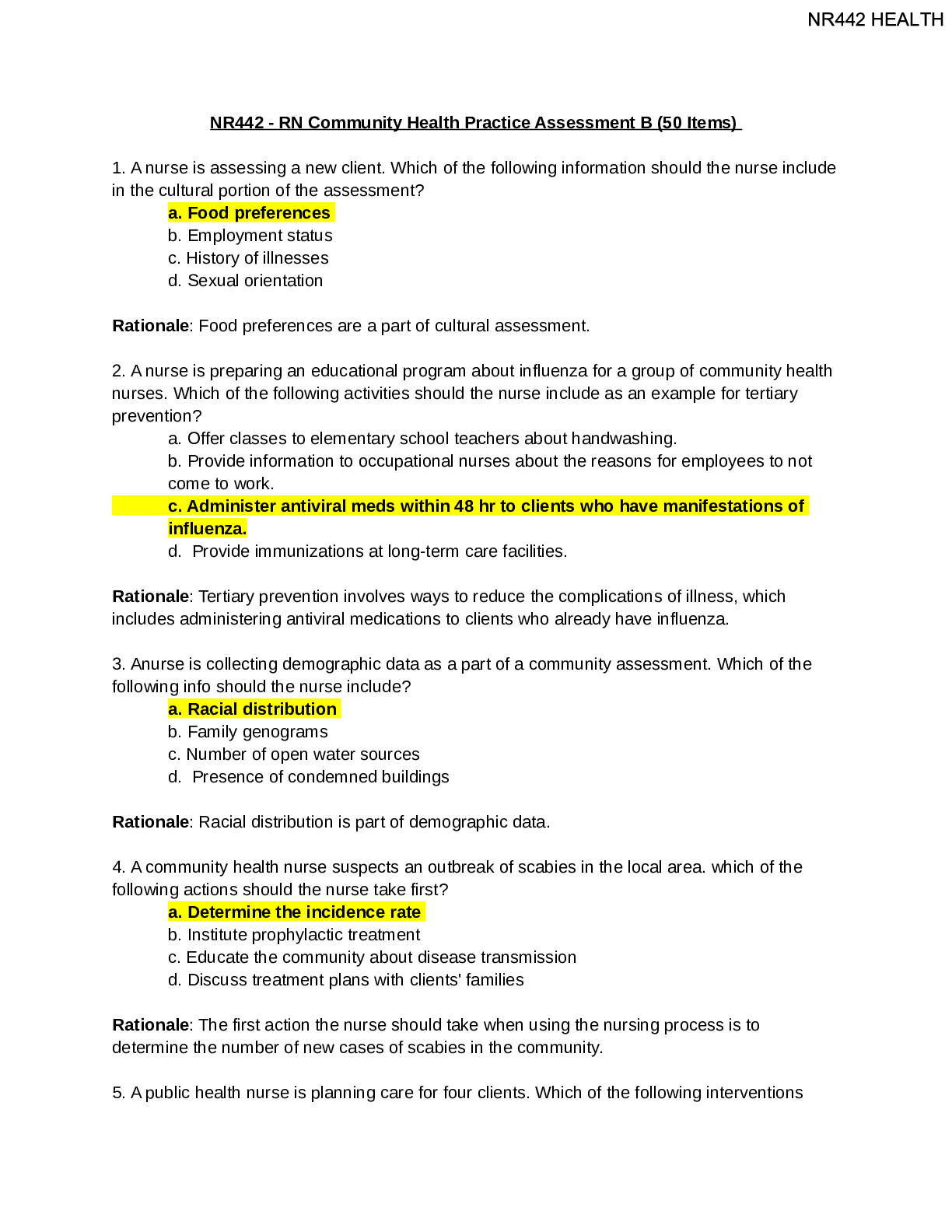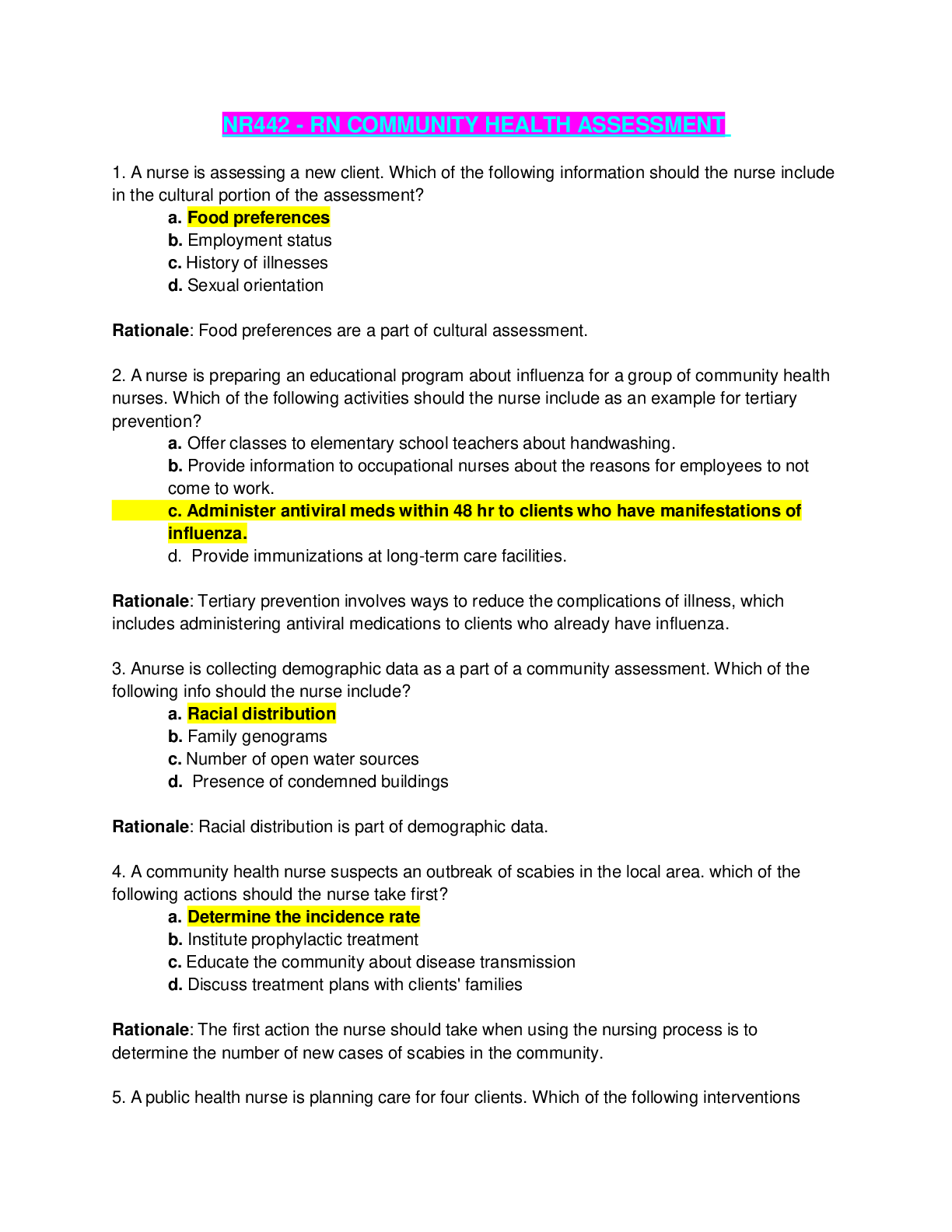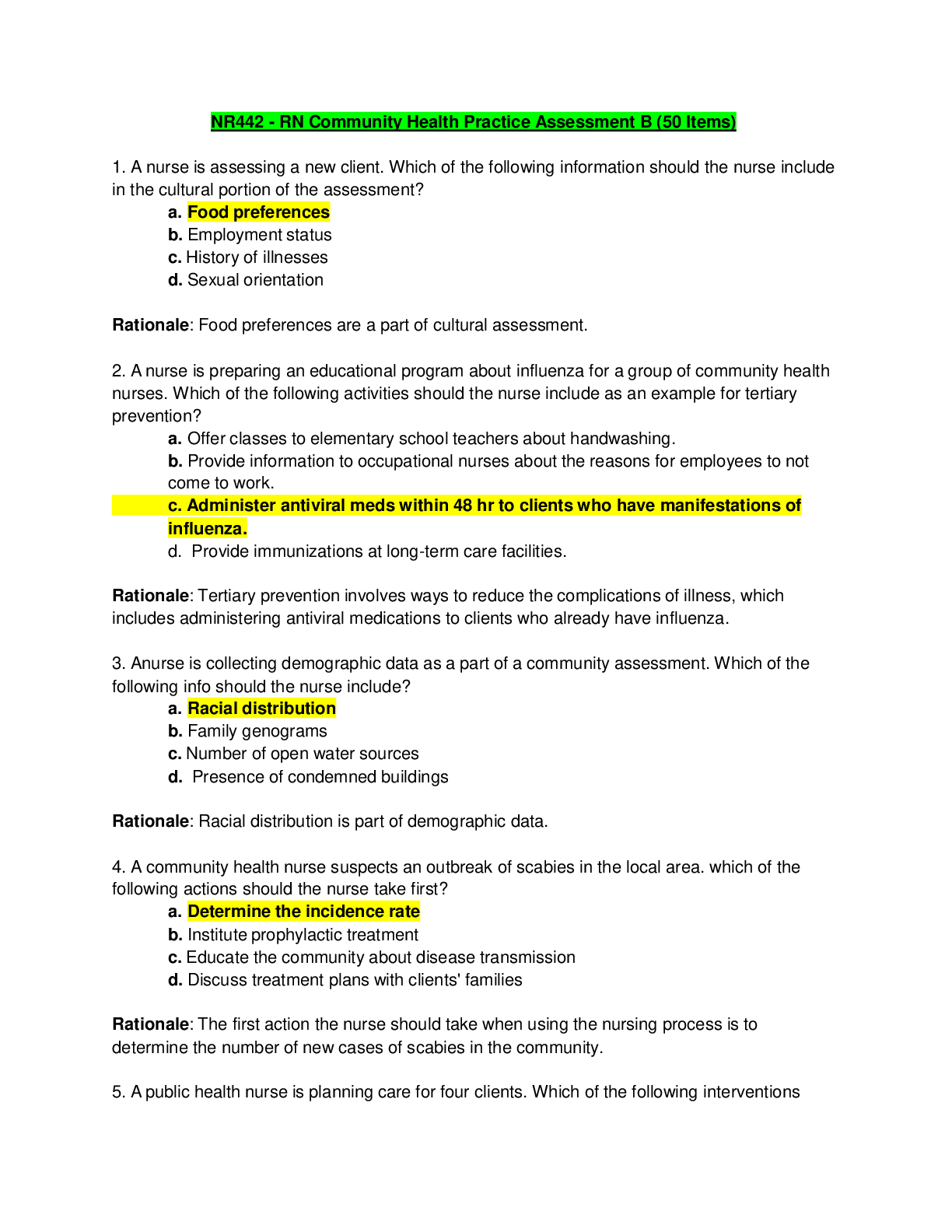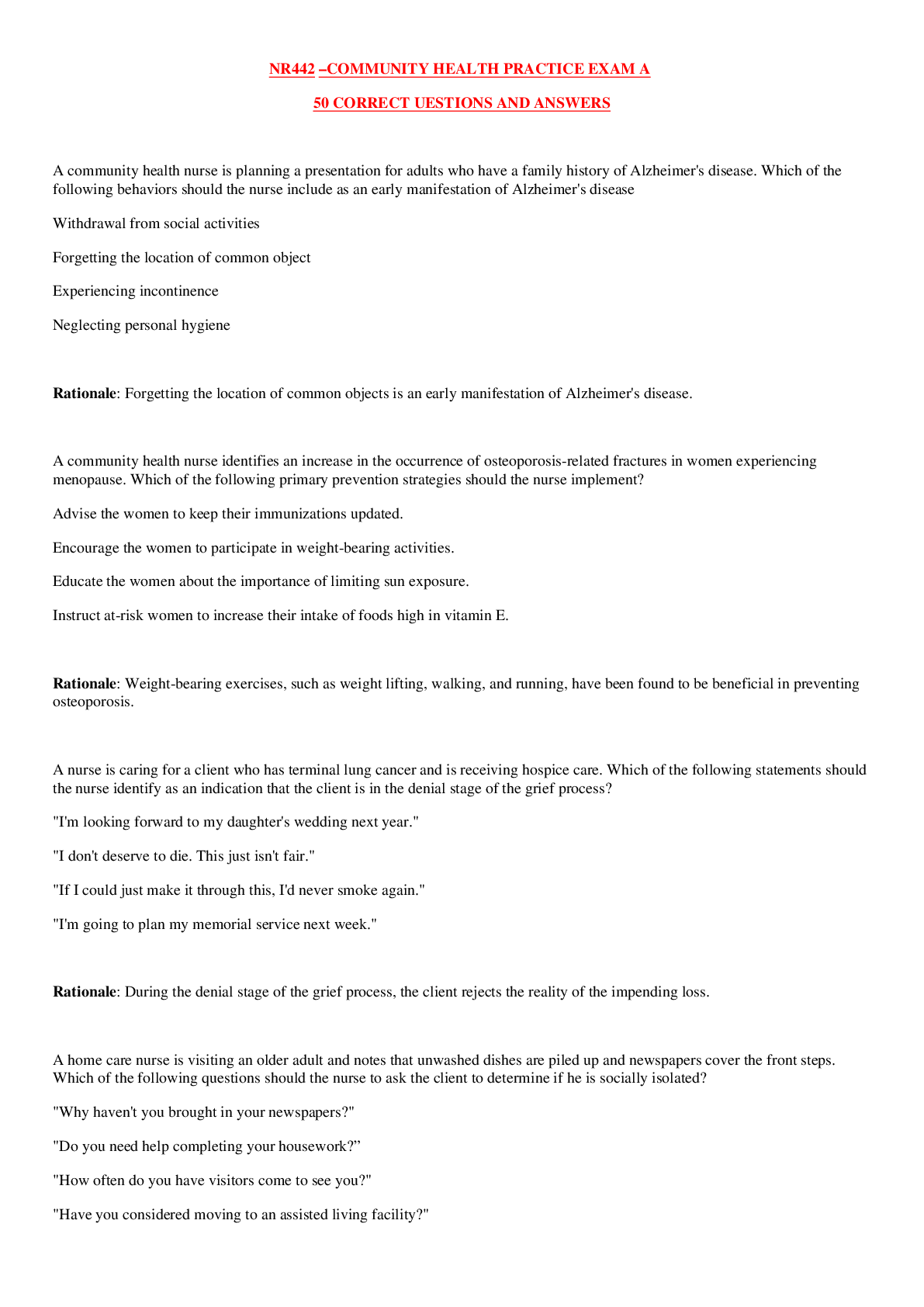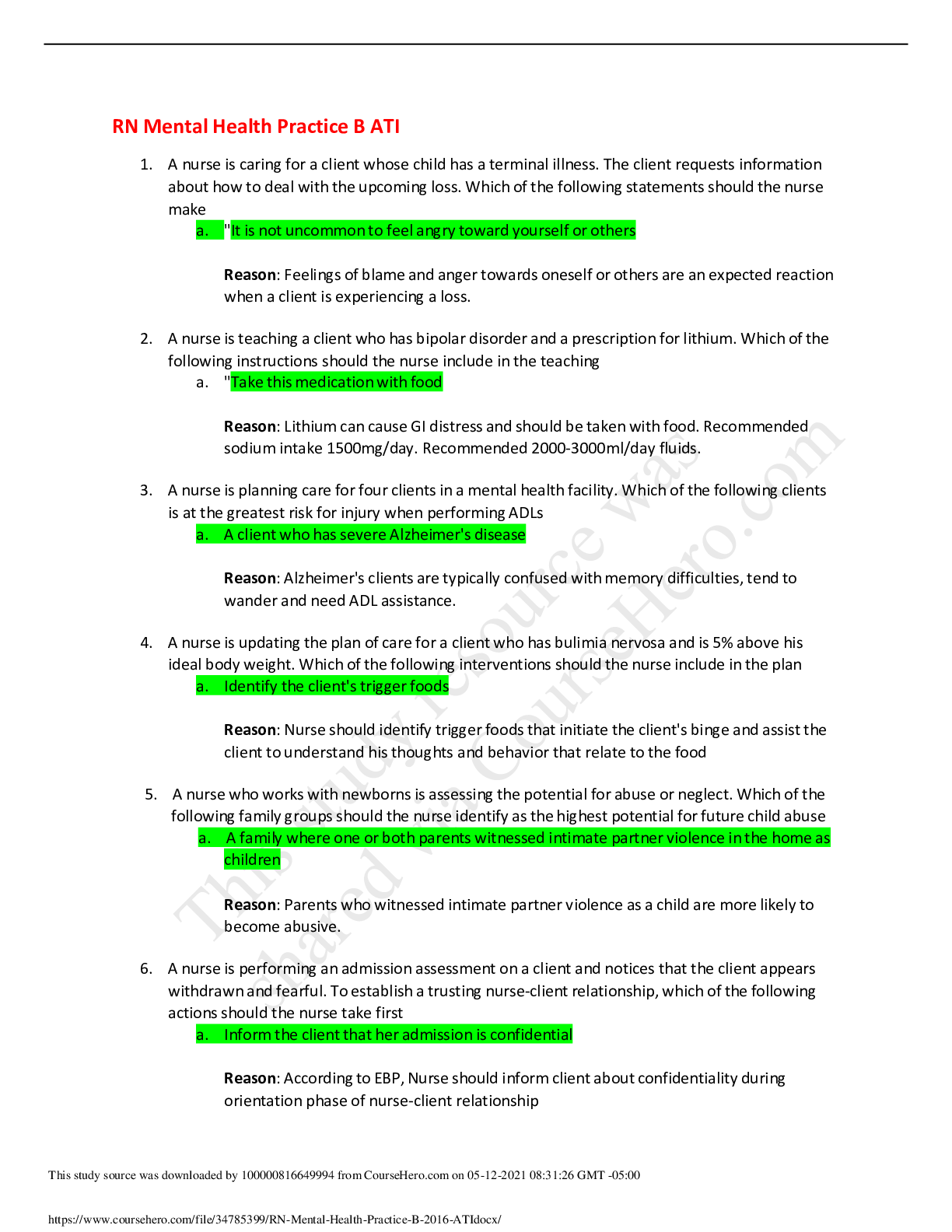NR 442 - RN Community Health Practice Assessment A ,100% CORRECT
Document Content and Description Below
NR442 - RN Community Health Practice Assessment A NR442 - Community Health Practice Exam A (50 Items) 1. A community health nurse is planning a presentation for adults who have a family history... of Alzheimer's disease. Which of the following behaviors should the nurse include as an early manifestation of Alzheimer's disease a. Withdrawal from social activities b. Forgetting the location of common object c. Experiencing incontinence d. Neglecting personal hygiene Rationale: Forgetting the location of common objects is an early manifestation of Alzheimer's disease. 2. A community health nurse identifies an increase in the occurrence of osteoporosis-related fractures in women experiencing menopause. Which of the following primary prevention strategies should the nurse implement? a. Advise the women to keep their immunizations updated. b. Encourage the women to participate in weight-bearing activities. c. Educate the women about the importance of limiting sun exposure. d. Instruct at-risk women to increase their intake of foods high in vitamin E. Rationale: Weight-bearing exercises, such as weight lifting, walking, and running, have been found to be beneficial in preventing osteoporosis. 3. A nurse is caring for a client who has terminal lung cancer and is receiving hospice care. Which of the following statements should the nurse identify as an indication that the client is in the denial stage of the grief process? a. "I'm looking forward to my daughter's wedding next year." b. "I don't deserve to die. This just isn't fair." c. "If I could just make it through this, I'd never smoke again." d. "I'm going to plan my memorial service next week." Rationale: During the denial stage of the grief process, the client rejects the reality of the impending loss. 4. A home care nurse is visiting an older adult and notes that unwashed dishes are piled up and newspapers cover the front steps. Which of the following questions should the nurse to ask the client to determine if he is socially isolated? a. "Why haven't you brought in your newspapers?" b. "Do you need help completing your housework?” c. "How often do you have visitors come to see you?" d. "Have you considered moving to an assisted living facility?" Rationale: "How often do you have visitors come to see you?" MY ANSWER The nurse should ask this question because it addresses the issue of social isolation by determining the frequency of contact between the client and others. 5. A community health nurse is discussing the role of a faith community nurse with a chaplain. Which of the following information should the nurse include in the discussion? a. The faith community nurse can provide pharmacologic pain management for clients who have a terminal illness. b. The faith community nurse can plan safety training for employees in a local factory. c. The faith community nurse can provide wound care for clients in their homes. d. The faith community nurse can facilitate substance abuse support groups. Rationale: This is one of the roles of a faith community nurse. 6. A community health nurse is conducting a needs assessment of a community. The nurse should identify that which of the following methods will yield direct data? a. Health surveys b. Medical records c. Informant interviews d. Morbidity/mortality statistics Rationale: The nurse should identify that informant interviews of the community's leaders will provide direct data. This information can help the nurse identify services needed by the community. 7. A nurse is providing education regarding lead exposure to a group of clients who live in a housing development built in 1968. Which of the following client statements indicates an understanding of the teaching? a. "I will use a dry-sanding technique when preparing to repaint my front door." b. "I will vacuum our wood floors every week." c. "I will increase the amount of red meat and milk in my child's diet." d. "I will use hot tap water to prepare my baby's formula." Rationale: Children should receive adequate amounts of iron and calcium in their diets to prevent lead absorption from their environment. 8. A community health nurse is participating in a quality improvement plan for a local health department. Which of the following techniques should the nurse use for process evaluation of the facility? (Select all that apply). a. Focus groups b. Written audits c. Satisfaction survey d. Interviews e. Values self-study Rationale: Focus groups is correct. The nurse should include focus groups, which are small groups of individuals who use the health department services, for process evaluation of the facility. This information allows for review of the facility's strengths and weaknesses in the quality of client care delivery. Written audits is correct. The nurse should include written audits, which are written evaluations of the quality of care provided by the health department, for process evaluation of the facility. This information allows for review of the facility's strengths and weaknesses in the quality of client care delivery. Satisfaction survey is correct. The nurse should include satisfaction surveys, which are assessments of clients' perception of their care made via telephone or written questionnaires, for process evaluation of the facility. Interviews is correct. The nurse should include interviews of clients who use the health department's services for process evaluation of the facility. Values self-study is incorrect. A values self-study is performed as the first step in quality assurance when the health department determines the needs of the community, the services to offer, and develops a philosophy and overall objectives for the facility. 9. A community health nurse is planning an in-service about STIs for a group of adolescents. Which of the following clinical findings should the nurse include as a manifestation of primary syphilis? a. Malaise b. Maculopapular rash on palms c. Chancre d. Lymphadenopathy Rationale: Chancre is a clinical manifestation of primary syphilis. All the others are symptoms are clinical manifestations of secondary syphilis. 10. A community health nurse is caring for an adolescent who is seeking help for unplanned pregnancy. Which of the following actions should the nurse take first? a. Recommend that the adolescent meet with the school guidance counselor to discuss educational options. b. Request permission to interview the father of the child to obtain a medical history c. Help the client obtain a provider for prenatal care d. Provide information on parenting classes so the client can learn about caring for a newborn Rationale: The client is an adolescent and experiencing an unplanned pregnancy, which are factors that place the client at risk for complications. Therefore, the first action the nurse should take is to assist the client in obtaining prenatal care. 11. 1. A community health nurse is planning to establish a community garden to address the lack of nutritious food options in the area. Which of the following actions should the nurse take first to initiate the plan? a. Identify community members who demonstrate an interest in the project. b. Hold a community information session to inform the residents of the plan c. Select residents to take on leadership roles in the project d. Monitor the progress of the project to keep the project on course Rationale: Identify community members who demonstrate an interest in the project. The first action the nurse should take when using the nursing process is to assess the community. By identifying those community members who demonstrate an interest in the project, the nurse can establish a local support group who will assist in engaging other community residents with establishing the garden. 12. A nurse is conducting a home visit for an older adult client. The nurse should identify which of the following findings as an indicator of possible neglect? a. Lives alone b. Taking outdated prescriptions c. Has a BMI of 25 d. Presence of alcohol in the home Rationale: Taking outdated prescriptions is an example of inadequate medical care and is an indicator of possible neglect. The client taking outdated prescriptions is an example of inadequate medical care and is an indicator of possible neglect. 13. A nurse is caring for a 16-year-old client who has a new diagnosis of human papillomavirus. Which of the following actions should the nurse take? a. Report the infection to the state health department b. Instruct the client to return for a blood test in 1 month. c. Administer ceftriaxone 250mg IM. d. Teach the client how to apply imiquimod 5% cream to the lesions. Rationale: The client can self-treat the lesions using topical imiquimod 5% cream to the lesions at bedtime for up to 16 weeks. 14. A school nurse is reviewing the records of four students who are returning to school after being diagnosed with methicillin-resistant staphylococcus aureus (MRSA). Which of the following actions should the nurse take? a. Coordinate an immunization clinic at the school b. Recommend prophylactic treatment for classmates c. Report the cases of MRSA to child protective services d. Provide education about MRSA throughout the school system Rationale: Appropriate hand hygiene and self-care will help prevent the spread of MRSA 15. A public health nurse is conducting an education session about Lyme disease for a group of older adult clients at a senior center. Which of the following statements should the nurse identify as an indication that the client understands the teaching? a. "I should get an annual immunization to prevent Lyme disease." b. "I can take penicillin for 10 to 14 days to manage Lyme disease." c. "I can get Lyme disease from a mosquito bite." d. "I will have abdominal pain and diarrhea if I get Lyme disease." Rationale: A client who receives a diagnosis of Lyme disease in the early stages should respond to 10 to 14 days of penicillin or tetracycline therapy. The nurse should instruct the students to consume less than 300 mg/day of dietary cholesterol. High levels of dietary cholesterol in a diet can be a risk factor for cardiovascular disease. 16. A school nurse is educating a group of high school student about recommended dietary guidelines. Which of the following statements by a student indicates an understanding of the teaching? a. "I can consume up to 25 percent of my daily calories from saturated fatty acids." b. "I should consume less than 300 milligrams per day of dietary cholesterol." c. "I can increase my daily consumption of foods that contain refined grains." d. "I should consume 800 milligrams per day of dietary calcium." Rationale: "I should consume less than 300 milligrams per day of dietary cholesterol." The nurse should instruct the students to consume less than 300 mg/day of dietary cholesterol. High levels of dietary cholesterol in a diet can be a risk factor for cardiovascular disease. 17. A community health nurse is creating a program to reduce domestic violence in the community. Which of the following interventions should the nurse identify as secondary prevention? a. Creating a public service announcement about the warning signs of intimate partner abuse b. Recognizing and reporting suspected abuse to the appropriate protective services c. Collaborating with support agencies to ensure the ongoing treatment for abuse e. Educating individuals and groups about preventing domestic and community abuse Rationale: Secondary prevention is an intervention that focuses on early detection of a health problem to facilitate early diagnosis and treatment. Recognizing and reporting suspected abuse facilitates diagnosis and intervention, helping to prevent further abuse. 18. A nurse in a clinic is planning teaching for a client who was newly diagnosed with hepatitis C. Which of the following instructions should the nurse include in the teaching? a. Consume a low-carbohydrate diet until symptoms resolve. b. Schedule an appointment for an immunoglobulin injection. c. Abstain from sexual intercourse until antibody tests are negative. d. Wear a mask in public places while receiving treatment. Rationale: Hepatitis C is transmitted through sexual intercourse. Therefore, the nurse should instruct the client to abstain from sexual intercourse until antibody tests are negative. 19. A nurse at a county health department is caring for a client who is at 28 weeks of gestation. The nurse should identify which of the following characteristics as a risk for potential future abuse of the newborn? a. The client recently married the father of her unborn baby. b. The client works part-time at a local restaurant. c. The client has changed providers three times during her pregnancy. d. The client has recurring nightmares about her unborn baby. Rationale: Frequently changing health care providers is a warning sign for potential future child abuse because it can indicate that the client is in an abusive relationship and is attempting to hide it from her provider. Clients who experience abuse are at a higher risk for abusing their own children. 20. A public health nurse is planning an educational program for a group of nurses at a community health department about pertussis infection. which of the following information should the nurse include? a. Individuals should receive an annual influenza vaccine to minimize the risk of infection with pertussis. b. Newborns should receive the first dose of the diphtheria, tetanus, and acellular pertussis (DTaP) vaccine prior to discharge from the hospital. c. Individuals who have had pertussis do not require immunization. d. Individuals transmit the pertussis bacteria through airborne droplets. Rationale: Transmission occurs when an individual who has an infection with Bordetella pertussis coughs and expels droplets smaller than 5 microns 21. A clinic nurse is caring for a client who reports taking ginkgo biloba for several weeks since seeing a naturopathic healer. The nurse should instruct the client that ginkgo biloba may alter the effects of which of the following medications? a. Warfarin b. Metoprolol c. Digoxin d. Diltiazem Rationale: Ginkgo biloba can hinder coagulation. Therefore, the nurse should instruct the client that ginkgo biloba may alter the effects of warfarin. 22. A home health care nurse is teaching a client's family about preventing the transmission of Clostridium difficile. Which of the following transmission-based precautions should the nurse include in the teaching? a. "You will be able to access my mother's hospital medical records for us to review." b. "You will be able to give my mother's pain medication." c. "You can submit invoices to Medicare to reimburse you for your services." d. "You will coordinate with volunteers who will come to help my mother." Rationale: A faith community nurse can assist with receiving services from various volunteers within the client's spiritual community to provide additional support and comfort to the client during the dying process. 23. A home health care nurse is teaching a client's family about preventing the transmission of Clostridium difficile. Which of the following transmission-based precautions should the nurse include in the teaching? a. Contact precautions b. Droplet precautions c. Airborne precautions d. Protective environment Rationale: Contact precautions. The nurse should instruct the family to implement contact precautions while providing care for a client who has C. difficile. Contact precautions eliminate the exposure to contaminated body fluids and items. Droplet precautions. The nurse should implement droplet precautions when providing care for a client who has diphtheria or mumps. Droplet precautions require the use of appropriate hand hygiene, the wearing of a surgical mask when within 3 feet of the client, and the use of dedicated care equipment. Airborne precautions. The nurse should implement airborne precautions when providing care for a client who has varicella, pulmonary tuberculosis, or measles. This type of precaution requires a negative airflow room and the wearing of an N95 mask. Protective environment. The nurse should implement protective environment precautions for clients who are highly susceptible to infections, such as clients who have severe dermatitis, major burns, leukemia, or who are undergoing chemotherapy. 24. A nurse is performing a home visit for a client who has tuberculosis (TB). As the nurse is leaving the client's house, a neighbor asks, "Is it true that my neighbor has TB?" Which of the following responses should the nurse make? a. "You should ask the public health department." b. "Do you have questions about tuberculosis?" c. "Have you ever been tested for tuberculosis?" d. "You should take precautions against this infection." Rationale: This response addresses the neighbor's concerns while protecting the client's confidentiality. 25. A nurse is developing a genogram for a client to determine education needs. Which of the following health risk information should the nurse expect to obtain with this tool? a. Biological b. Behavioral c. Social d. Economic Rationale: Biological. A family genogram tracks the incidence of disease over multiple generations of a family and will identify biological risk factors. 26. An occupational health nurse is assessing a client who reports taking ibuprofen daily. The nurse should counsel the client about the risk for which of the following adverse effects? a. Gastric ulceration b. Orthostatic hypotension c. Hyperglycemia d. Urinary retention Rationale: Daily use of NSAIDs, such as ibuprofen, increases the risk of gastric ulceration, perforation, and hemorrhage. 27. A nurse is giving a presentation about family violence at a local community center. Which of the following information should the nurse include? a. Minority populations may be at greater risk for abuse. b. Intimate partner abuse occurs more frequently in lower socioeconomic households. c. Child abuse is more common in homes where intimate partner abuse is present. d. Children who are abused are less likely to become abusers. Rationale: Child abuse is very common in homes where intimate partner abuse is present. 28. A nurse in an emergency department is triaging clients following an explosion at a local factory. Which of the following clients should the nurse identify as the priority? a. A client who has superficial burns to 10% of the abdomen b. A client who has tracheal deviation and shortness of breath c. A client who has agonal respirations and an open head injury d. A client who has a fracture of the humerus and a bleeding foot laceration Rationale: A client who has tracheal deviation and shortness of breath most likely has a pneumothorax and requires immediate intervention for survival. Therefore, when using the survival approach to client care, the nurse should give priority to this client. 29. A public health nurse is planning a community health promotion program for hypertension prevention. Which of the following interventions should the nurse include as a tertiary prevention strategy? a. Provide education about risk factors for hypertension. b. Conduct a hypertension screening clinic for the community. c. Teach clients who have a family history of hypertension how to monitor blood pressure. d. Implement an exercise program for clients who have hypertension. Rationale: Implement an exercise program for clients who have hypertension. MY ANSWER The nurse should implement tertiary prevention strategies for clients who have hypertension to promote the highest level of functioning possible, which can include regular exercise to maintain an active lifestyle. 30. A home health nurse is conducting a follow-up visit for a client who was recently discharged from an acute rehabilitation program. Which of the following actions should the nurse take? a. Tell the client to take naltrexone daily. b. Instruct the client to take buprenorphine for the next 9 to 12 months. c. Teach the client to avoid foods that contain tyramine. d. Schedule transcranial magnetic stimulation (TMS) biweekly. Rationale: The nurse should instruct the client to take naltrexone daily to decrease her cravings for alcohol. Naltrexone is prescribed to assist the client with alcohol withdrawal and prevent relapse. 31. A nurse is assessing a new client at a public health clinic. Which of the following areas should the nurse address as part of the cultural assessment? a. Immunization status b. Sexual activity c. Illness practices d. Food allergies Rationale: A cultural assessment focuses on beliefs, values, meanings, and behavior of people within a client's cultural, ethnic, or religious group. This includes culturally-based practices that relate to health and illness. 32. A school nurse is notified that a school-age child has been newly diagnosed with pertussis. Which of the following actions should the nurse take? (Select all that apply.) a. Instruct the parent to keep the child at home until the coughing stage has passed. b. Encourage family members to obtain prophylactic treatment. c. Quarantine the children in the child's class. d. Recommend that the child receive a pneumococcal vaccine in 28 days. e. Check the immunization status of the child's classmates. 33. A nurse is caring for a client who has stage IV pancreatic cancer and has received information regarding available treatment options. Which of the following is the responsibility of the nurse if the client chooses to forgo treatment and enter hospice care? a. Make the hospice referral in accordance with the client's decision b. Verify that the client's health insurance pays for hospice services c. Recommend a second opinion from another provider d. Assess whether or not the family agrees with the client's decision Rationale: The nurse should follow the ethical principle or respect for client autonomy and make the hospice referral for the client. 34. A nurse is preparing a community education program about health care needs during pregnancy. The nurse should include which of the following vaccines is safe to administer to a client who is pregnant? a. Herpes zoster b. Tetanus, diphtheria, pertussis (Tdap) c. Varicella d. Measles, mumps, rubella Rationale: The nurse should include that a client who is pregnant should receive the Tdap vaccine between 27 and 36 weeks of gestation. 35. A community health nurse is providing care to a client who has stopped taking his prescribed blood pressure medication. Which of the following actions should the nurse take first? a. Inform the provider of the client's decision b. Determine the client's reason for discontinuing the medication c. Discuss the consequences of discontinuing the medication with the client d. Provide the client with an educational pamphlet about the medication Rationale: When using the nursing process, the first step the nurse should take is to assess the client. By determining the client's reason for discontinuing the medication, the nurse can promote adherence to treatment. 36. Community leaders have requested a meeting with a community health nurse to discuss creating a mobile meals program. Which of the following should the community health nurse assess first? a.The leadership support of the community b. The availability of volunteers c. The availability of volunteers d. The need for the program Rationale: Using the urgent vs. nonurgent approach to client care, the nurse should first assess the need for the mobile meals program. This action allows the nurse to collect data on the client, which is the community, and meets the first step of program planning. The needs of the community will determine all other steps of the planning process. 37. A nurse is preparing to administer medication to a client who has active tuberculosis. Which of the following precautionary measures should the nurse take? a. Wear gloves. b. Wear a gown. c. Use disposable equipment. d. Use an N95 respirator. Rationale: A client who has active TB require airborne precautions to prevent the spread of droplet nuclei smaller than 5 microns. The nurse should wear an N95 respiratory when administering medication to prevent transmission of the infection. 38. A community health nurse is reviewing plans for a health education program. The nurse should identify that which of the following components of the plan needs to be changed? a. Program content is organized topically. b. Pamphlets are written at a 12th-grade level. c. The presentation is delivered via a computer slide presentation. d. Attendance at the program is voluntary Rationale: The nurse should identify that the pamphlets written at a 12th-grade reading level requires a change. The American Medical Association and the National Institutes of Health recommend written materials are written at a 6th-grade level or lower. 39. A nurse is planning a health promotion activity for the local community. Which of the following activities should the nurse include as an? a. Teaching foot care to adults who have diabetes mellitus b. Testing school-age children for lead exposure c. Providing tuberculosis screenings for day care providers d. Teaching meal planning classes to older adults Rationale: This is an example of primary prevention. 40. A home health nurse is providing nutritional instructions to a client who has COPD and is malnourished. Which of the following instructions should the nurse include? a. Drink at least 480 mL (16 oz) of liquid with each meal. b. Avoid foods that contain eggs c. Lie flat for 15 to 30 mins after eating d. Use milk instead of water when making canned soup Rationale: The client should use milk when preparing canned soup to increase his intake of protein and calories. 41. A nurse in a pediatric clinic is providing care to several clients. The nurse should recognize that which of the following conditions is included on the Nationally Notifiable Infectious Conditions list? a. Varicella b. Erythema infectiosum c. Scarlet fever d. Molluscum contagiosum Rationale: The nurse should recognize that varicella is included on the Nationally Notifiable Infectious Conditions list. States voluntarily conduct surveillance and report instances of certain diseases to the Centers for Disease Control and Prevention so the data can be compiled and released each year. 42. A nurse is caring for a client who has recently emigrated from another country and states, "The health care system in my country was better and should be used everywhere." The nurse should recognize that the client is demonstrating which of the following behaviors? a. Social organization b. Cultural imposition c. Ethnocentrism d. Stereotyping Rationale: Ethnocentrism occurs when people view the world from the perspective of their own cultural background and viewpoint 43. A community health nurse is providing teaching about health promotion to a group of adolescents. Which of the following topics is most important for the nurse to include in an attempt to lower adolescent mortality rates? a. Underage smoking b. Safer sex practices c. Safety belt use d. Heart-healthy diet Rationale: Automobile crashes are currently the leading cause of death among adolescents. Therefore, this topic is most important to discuss when attempting to reduce premature deaths in this age group. 44. A nurse in an emergency department is caring for a client who is homeless and has hypothermia. Which of the following actions should the nurse take? a. Notify the local law enforcement agency of the client's situation b. Initiate a referral to the facility's social worker. c. Ask the client why he did not seek shelter sooner. d. Tell the client that everything will work out now that he is in the hospital. Rationale: Initiate a referral to the facility's social worker. The nurse should refer the client to the facility's social worker or to an agency that can assist him with finding housing. 45. A nurse in a community health clinic is preparing to administer an immunization to a 5-year- old child. Which of the following actions should the nurse take? Ask the child to pretend to blow up a balloon during the injection. Reassure the child that the injection is not going to hurt. Ask the child's parent to leave the room during the injection. Request that the child count backwards from the number 10 during the injection. Rationale: The nurse should ask the child to pretend to blow up a balloon during the injection. This serves as a distraction for the child, which decreases pain perception. 46. A nurse is developing a community education program about risk factors for family violence. The nurse should include which of the following circumstances as a risk factor for? a. Attempting to end the relationship b. Lacking supportive friends outside the relationship. c. Having health issues that limit independence d. Taking antianxiety or sedative medications Rationale: Clients who are in a relationship with a potential or actual abuser heighten their risk for intimate partner abuse when they attempt to leave the relationship. 47. A home health nurse is planning care for a client who reports practicing traditional Asian health beliefs. The nurse should recognize that the client participates in which of the following actions? a. Place a cup of steam against the skin to draw out toxins from the body b. Applies cool compresses across the body to reduce fever c. Avoids eating dairy and meat products during the same meal d. Visits a shaman to seek healing from illness Rationale: The nurse should recognize that a health-related practice for clients who practice traditional Asian health beliefs includes cupping, which involves placing the open end of a cup of steam against the skin. A vacuum seal is created as the steam cools. When the cup is removed, it is believed that toxins are drawn out from the body. 48. A community health nurse is conducting vision screenings at a health fair for an older adult client who has age-related macular degeneration. Which of the following statements should the nurse identify as an indication that the client is adapting to the changes? a. "I have a prescription bottle magnifier to help me read my pill bottle labels." b. "I canceled all of my magazine prescriptions since I can't read them." c. "I purchased green towels to use in my bathroom." d. "I have learned that I cannot to go outside when the sun is bright." Rationale: The client can obtain a prescription bottle magnifier, or other low-vision optical devices, to assist him in his ability to read the labels on his prescriptions and remain independent. 49. A community health nurse is participating in a group session for clients who have alcohol and substance use disorders. Which of the following information should the nurse provide regarding support programs for these individuals? a. Alcoholics Anonymous (AA) is a support group that requires disclosure of attendance to employ]ers. b. Narcotics Anonymous (NA) is a one-on-one program that assists clients. c. Alcoholics Anonymous (AA) assists a client who has an addiction to alcohol with developing a daily recovery program. d. Narcotics Anonymous (NA) will cure a client from her substance use disorder if she stays involved with the program. Rationale: AA is a support group that will assist a client who has an addiction to alcohol and other substances with developing a daily recovery program using a 12-step approach. AA's primary purpose is to help the client obtain and maintain sobriety. 50. An occupational health nurse in a factory is performing a routine tuberculosis screening and identifies an employee who has a positive Mantoux tuberculin test. Which of the following actions should the nurse take? a. Instruct the employee to prepare a list of close personal contacts. b. Initiate an employee immunization program. c. Instruct the employee to wear an N95 respiratory mask. d. Administer prophylactic penicillin to other employees. Rationale: The nurse should report the name of an employee who has a positive Mantoux tuberculin test to the health department. The health department will follow up with the employee so that close personal contacts can be notified of the potential of exposure [Show More]
Last updated: 1 year ago
Preview 1 out of 28 pages
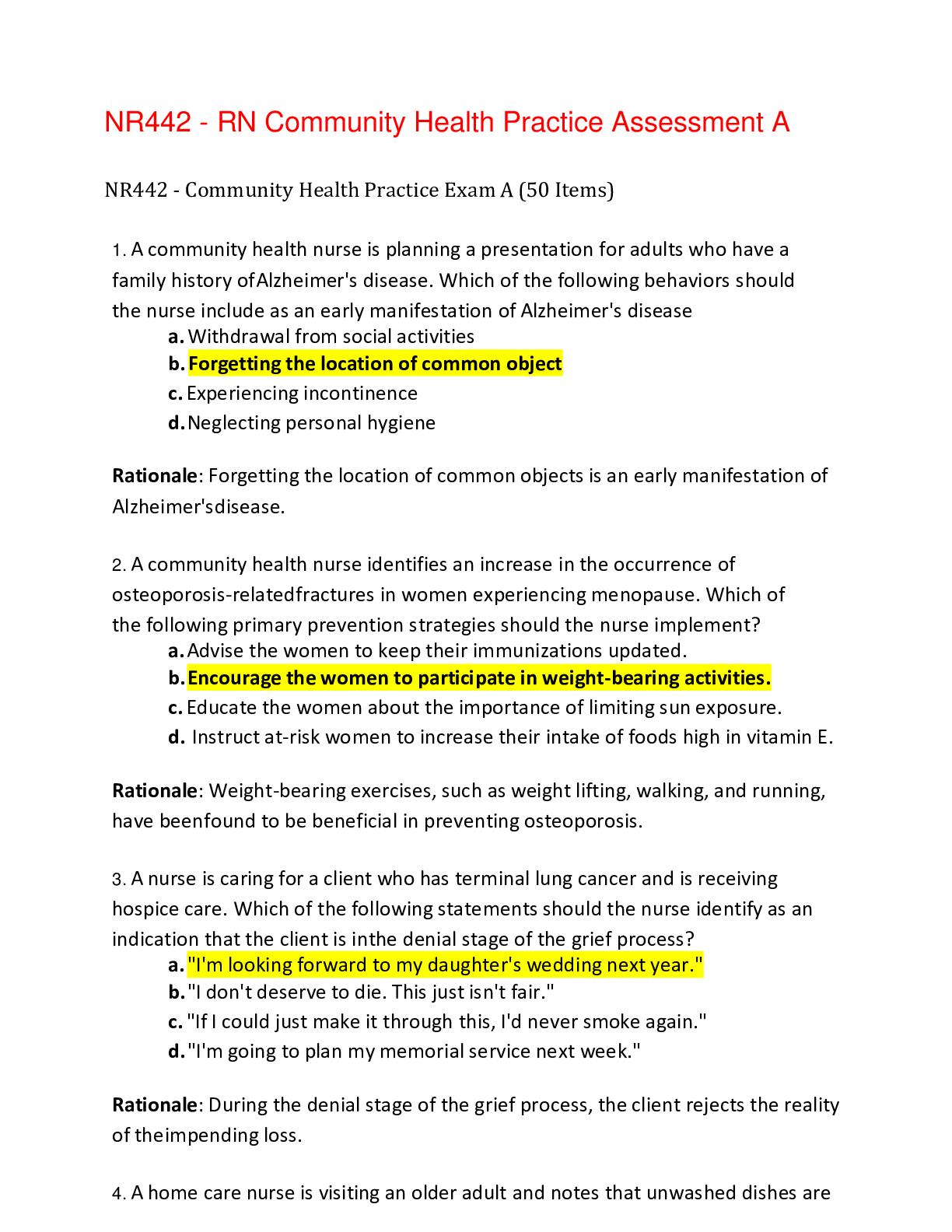
Reviews( 0 )
Document information
Connected school, study & course
About the document
Uploaded On
Jan 25, 2022
Number of pages
28
Written in
Additional information
This document has been written for:
Uploaded
Jan 25, 2022
Downloads
0
Views
36

















